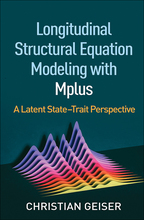Longitudinal Structural Equation Modeling with Mplus
A Latent State-Trait Perspective
Christian Geiser
Guide to Statistical Symbols
1. A Measurement Theoretical Framework for Longitudinal Data: Introduction to Latent State–Trait Theory
1.1 Introduction
1.2 Latent State–Trait Theory
1.3 Chapter Summary
1.4 Recommended Readings
2. Single-Factor Longitudinal Models for Single-Indicator Data 
2.1 Introduction
2.2 The Random Intercept Model
2.3 The Random and Fixed Intercepts Model
2.4 The ?-Congeneric Model
2.5 Chapter Summary
2.6 Recommended Reading
3. Multifactor Longitudinal Models for Single-Indicator Data
3.1 Introduction
3.2 The Simplex Model
3.3 The Latent Change Score Model
3.4 The Trait–State–Error Model
3.5 Latent Growth Curve Models
3.6 Chapter Summary
3.7 Recommended Readings
4. Testing Measurement Equivalence in Longitudinal Studies
4.1 Introduction
4.2 The Latent State (LS) Model
4.3 The Latent State Model with Indicator-Specific Residual Factors (LS-IS Model)
4.4 Chapter Summary
4.5 Recommended Readings
5. Multiple-Indicator Longitudinal Models
5.1 Introduction
5.2 Latent State Change (LSC) Models
5.3 The Latent Autoregressive/Cross-Lagged States (LACS) Model
5.4 Latent State–Trait (LST) Models
5.5 Latent Trait Change (LTC) Models
5.6 Chapter Summary
5.7 Recommended Readings
6. Modeling Intensive Longitudinal Data
6.1 Introduction
6.2 Special features of Intensive Longitudinal Data
6.3 Specifying Longitudinal SEMs for Intensive Longitudinal Data
6.4 Chapter Summary
6.5 Recommended Readings
7. Missing Data Handling
7.1 Introduction
7.2 Missing Data Mechanisms
7.3 Maximum Likelihood Missing Data Handling
7.4 Multiple Imputation (MI)
7.5 Planned Missing Data Designs
7.6 Chapter Summary
7.7 Recommended Readings
8. How to Choose between Models and Report the Results
8.1 Model Selection
8.2 Reporting Results
8.3 Chapter Summary
8.4 Recommended Readings
References
Author Index
Subject Index



